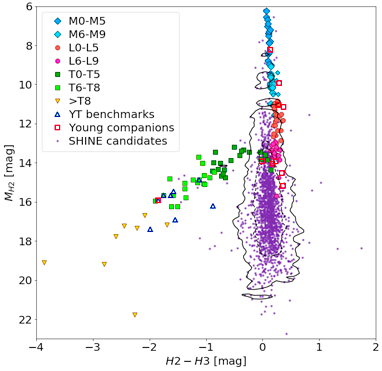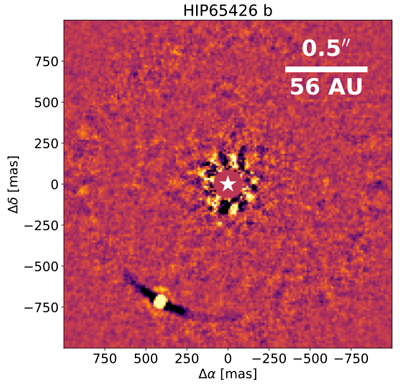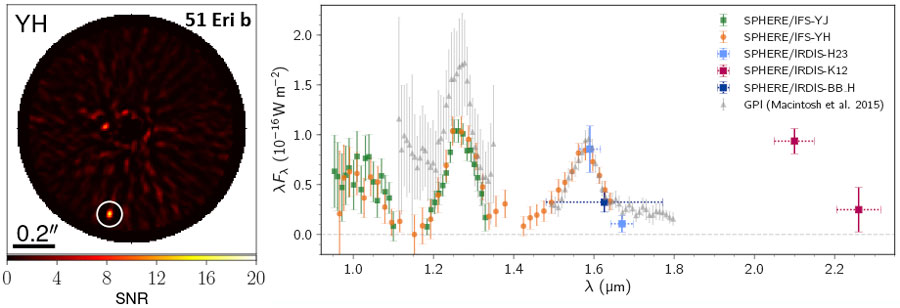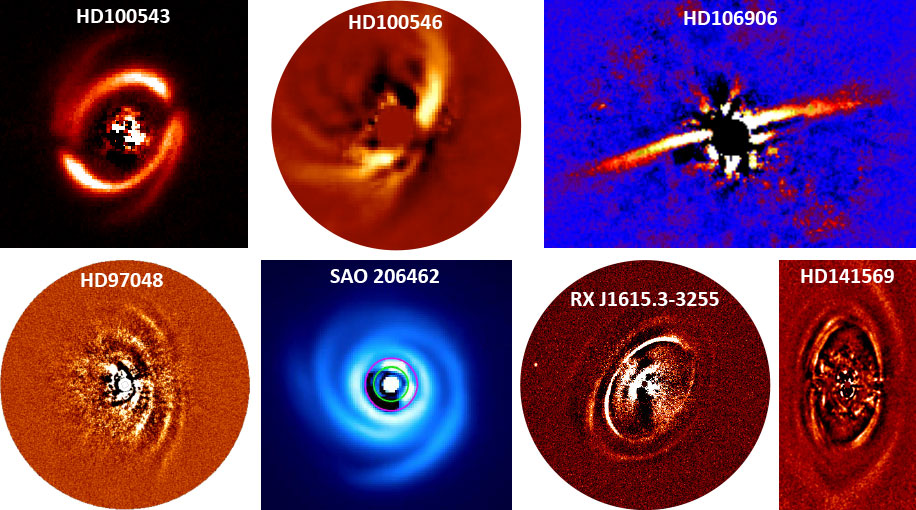SHINE
Context and goals
SHINE (SpHere INfrared survey for Exoplanets) is a large scale direct imaging survey performed with the second-generation high-contrast imager VLT/SPHERE on the guaranteed time of observations (GTO). With a total number of 200 nights, the goal is to perform a census of young giant exoplanets in the Solar neighborhood. The complete sample is constituted of more than 500 stars (see plots below) categorized in 5 priorities, with the highest priority given to the youngest and most nearby stars.
The scientific goals of SHINE are multiple:
- Determine the frequency of giant exoplanets in the 10-50 AU range as a function of age, spectral type, stellar mass, etc
- Detect new giant exoplanets and circumstellar disks
- Study the atmospheres of known and new exoplanets
- Understand the formation of giant exoplanets
- Study the dynamics of planetary systems
- Calibrate the multiple models related to giant exoplanets (formation, evolution, atmosphere, etc)

Status of the survey
Observations
All SHINE observations were concluded in 2023, but the follow-up programme SnapSHINE is still on-going. SHINE observations are performed during 1 to 2 hours with an apodized pupil Lyot coronagraph (APLC; Soummer 2005) in angular differential imaging (ADI; Marois et al. 2006). Data are obtained in parallel with the integral field spectrograph (IFS; Claudi et al. 2008) and the infrared dual-band imager in spectrograph (IRDIS; Dohlen et al. 2008) in dual-band imaging mode (DBI; Vigan et al. 2010). This unique instrumental setup enables covering the whole near-infrared in a single shot to maximize the efficiency of the observations. The data are then analyzed at the SPHERE data center (SPHERE-DC) hosted in Grenoble (France), and with individual pipelines when focused studies are performed. The pipelines derive final images, detection limits and astro-photometry for all the identified candidates in the images.
Additional characterization observations are performed with IRDIS using the long-slit spectroscopy mode (LSS;Vigan et al. 2008) for sub-stellar companions or using the dual-polarimetry mode (DPI; Langlois et al. 2014) for circumstellar disks.
Detected candidates

With a field-of-view diameter of more than 8", the IRDIS/DBI mode offer a high probability of contamination by background stars (see e.g. Chauvin et al. 2015). After more than 4 years of survey, we have detected more than 3000 candidates around 300+ targets. The plot at the right shows all of them in a color-magnitude diagram (CMD) for the IRDIS H2H3 DBI filter pair. An important part of the work, for which I am the SHINE responsible, is the identification and classification of all these candidates. There are 3 possible ways to determine the status of candidates: using two (or more) SHINE epochs separated by at least a few months, using SHINE measurements in combination with archival data (e.g. from DIVA) or excluding some candidates based on their color and absolute magnitude in CMDs. By combining these different methods, we managed to determine that 241 candidates (10.7%) are background, 32 candidates (1.4%) are companions (known or new, stellar and sub-stellar), 19 candidates (0.8%) are ambiguous and the rest is undefined. Additional selection criteria are now considered to reduce the number of interesting candidates and hopefully obtain an almost complete status by the end of SHINE in 2020.
Results

A major result of SHINE is the discovery of a new giant exoplanet around HIP 65426 (Chauvin, Desidera, Lagrange, Vigan et al. 2017). The A2 star is a member of the young (~17 Myr) Lower Centaurus-Crux association, at a distance of 111 pc. Interestingly, and contrary to most imaged exoplanets host stars, HIP 65426 does not exhibit an infrared excess. The star was observed for the first time in May 2015 as part of the standard SHINE campaign, revealing the presence of a point source at a separation of 830 mas and a contrast of ~11 mag in H-band. New observations in February 2017 confirmed the common proper motion and the planetary status of the candidate. Spectro-photometric measurements from the IFS and IRDIS between 0.95 and 2.2 μm indicate a warm, dusty atmosphere characteristic of young low surface-gravity L5-L7 dwarfs. Hot-start evolutionary models predict a luminosity consistent with a 6-12 MJup and Teff = 1300-1600 K. New observations are already foreseen to better constrain the SED and the physical parameters of this new giant planet orbiting at a projected separation of 92 AU from its host star.

Another major discovery is the first unambiguous detection of a protoplanet embedded in the protoplanetary disk surrounding the very young (5 Myr) T Tauri star PDS 70 (Keppler et al. 2018). With an estimated semi-major axis of 22 AU, this massive planet is located within the cavity detected in the disk. Subsequent follow-up of the companion with Mag-AO (Wagner et al. 2018) and more recently VLT/MUSE (Haffert et al. 2019) in the Hα line demonstrated that the object is still actively accreting gas from the circumstellar or circumplanetary disk. In addition, the VLT/MUSE observations have also revealed the presence of a possible second planetary companion that is also accreting. This candidate was identified in the SPHERE data but could not be safely confirmed due to its location close to the outer dust belt. Finally, ALMA observation have also detected unresolved structures in the continuum emission at 855 μm at the location of the PDS 70 c candidate, likely indicating the presence of a circumplanetary disk from which the candidate protoplanet would be accreting gas. Overall, this system is an amazing laboratory showing planet formation in action! This probably constitutes the most significant discovery of the SHINE survey.
A significant part of SHINE is also dedicated to the detailed characterization of know sub-stellar companions, like the 4 planets around HR8799 (Marois et al. 2010; Zurlo, Vigan et al. 2016; Bonnefoy et al. 2016), the companion around β Pictoris (Lagrange et al. 2010; Lagrange et al. 2019), the new planet discovered by GPI around 51 Eri (Macintosh et al. 2015; Samland et al. 2017, see illustration below) and others. SPHERE/IRDIS offers a long-slit spectroscopy mode coupled with a Lyot coronagraph, which offers a resolution up to R=350 unique in the small world of high-contrast imager and spectrographs. This has showed good performance for the characterization of companions at moderate contrasts (Hinkley et al. 2015; Mesa et al. 2016; Bonavita et al. 2018; Cheetham et al. 2018; Mesa et al. 2020)
.
In 2021 we published a series of three papers describing the early results of the survey, focusing on the first 150 targets observed in SHINE. They present the sample selection (Desidera et al. 2021) the observation and data analysis (Langlois et al. 2021), and the first statistical inference based on the SHINE data (Vigan et al. 2021). The full analysis of the survey is in preparation and will be published in 2024. An observing programme called SnapSHINE is currently on-going to determine the status of most unconfirmed candidates from SHINE (PI: Beuzit & Chauvin).
Finally, with its wide field-of-view and its polarisation capabilities, SPHERE/IRDIS is a unique instrument to detect and study protoplanetary and debris disks (de Boer et al. 2020; van Holstein et al. 2020) Below is a (very incomplete) gallery of some images obtained with SPHERE in SHINE and in the disk GTO (20 nights).

Collaborators
SHINE is a large collaborations with several dozens of contributors.
SHINE coordination team: Gaël Chauvin, Silvano Desidera, Janis Hagelberg, Anne-Marie Lagrange, Raffaele Gratton, Maud Langlois, Mickaël Bonenfoy, Michael Meyer, Markus Feldt.
SHINE team at LAM: Hervé Le Coroller, Élodie Choquet, Jean-Luc Beuzit, Alice Zurlo (associated scientist, former PhD student), Zahed Wahhaj (associated scientist).
Other close collaborators: Mariangela Bonavita, Beth Biller, Faustine Cantalloube, Valentina D'Orazi, Clémence Fontanive, Dino Mesa, Julien Milli, Michael Meyer.